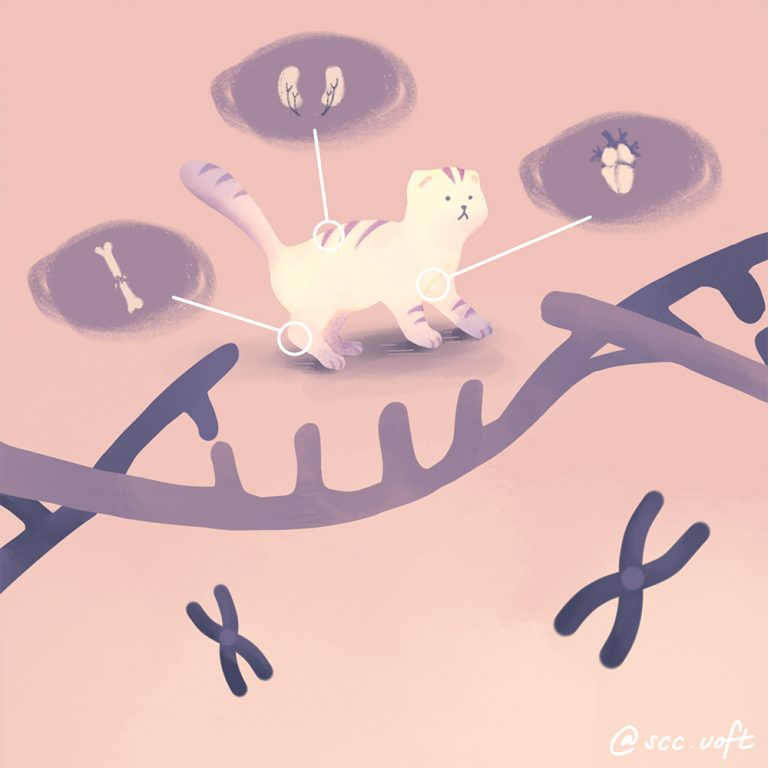
Written by Melissa Wong
Illustrated by Anna Tram
Is your guilty pleasure watching cat videos? If so, you are probably familiar with adorable round-faced cats with folded ears. This cat breed is known as the Scottish Fold Cat. And yes, they do originate from Scotland! In fact, all Scottish Fold Cats descend from a white cat named Suzie who lived in a barn in Scotland in the early 1960s. As the story goes, a cat lover took interest in the folded ears and adopted Suzie’s floppy eared daughter, Snooks, where he began breeding the line of Scottish Folds, and the rest is history! Unfortunately, as appealing as these cats are, there are serious health concerns when it comes to breeding Scottish Folds.
Scottish Folds are susceptible to osteochondrodysplasia. “Osteo” and “chondro” are derived from the Greek words for bone and cartilage, and “dysplasia” simply means an abnormal growth of cells. Thus, osteochondrodysplasia describes the abnormal growth of cells in the bones and cartilage. This makes sense as cat ears are composed of cartilage and alteration to the ear composition will cause their ears to bend. Unfortunately, the joints and the bones in the cats’ limbs and tails are also affected. This can cause immense pain in Scottish Folds as part of their skeletons are being deformed from the abnormal growth.
A dominant gene mutation is responsible for the floppy ears and osteochondrodysplasia observed in Scottish Folds. A dominant gene mutation simply means that if a copy of the mutant gene is inherited in the offspring, the offspring will definitely display the mutation. In animals, each parent passes down one copy of a gene, this means that the offspring will have two copies of the gene. For example, if Parent A has one mutant gene and one normal gene, say for folded ears, and Parent 2 has two normal genes, then folded ears will be passed on to the offspring only if the offspring inherits a copy of the mutation from Parent A. If you do the math, there is only a 50% probability that the offspring will inherit folded ears because there is a 50% probability of getting the mutant gene from Parent A: 1 mutant gene / 2 genes total = 1/2 = 50%
This is actually the standard practice for breeding Scottish Folds where one parent is a crossbred Scottish Fold -the cat only has one copy of the mutant gene for folded ears- and the other parent is of another cat breed -with no folded ears, and thus, no mutant gene- to avoid producing purebred Scottish Folds (cats that have two mutant genes). The reason being that Purebred Scottish Folds exhibit earlier onset of osteochondrodysplasia and a greater severity of symptoms compared to crossbreeds. Technically speaking, inbreeding a Scottish Fold with folded ears to a Scottish Fold with straight ears would overcome the problem of producing purebreeds as the straight ear cat would be assumed to not possess the mutation, but there are cases where the Scottish Folds have a mutant gene but appear to have straight ears. To avoid ambiguity, Scottish Folds are outbred with common breeds being the Persian and British Shorthair as they do not have the mutant gene for folded ears.
However, there are unintended consequences to outbreeding which include being at risk for polycystic kidney disease and hypertrophic cardiomyopathy. Polycystic kidney disease, as the name describes, is the growth of cysts in the kidneys which can lead to decreased kidney function. Hypertrophic cardiomyopathy is a disease characterized by the thickening of the heart’s wall which makes contracting the heart and pumping blood harder. Persians are susceptible to polycystic kidney disease while British Shorthairs are likely to suffer from hypertrophic cardiomyopathy. Both diseases are the result of dominant mutations, meaning that only one copy of the mutant form of the gene is enough to have the disease.
Scottish Folds will often find themselves suffering from problems not only in their skeletal system, but elsewhere in the body too. Ultimately, this all comes down to the question: should the aesthetics of domestic pets outweigh animal welfare? The Scottish Fold breed is only one example of the many domestic pets that have their health compromised for aesthetic purposes. Future pet owners, maybe consider adopting a pet from the animal shelter instead of a breeder!
Sources:
- Gandolfi B, Alamri S, Darby WG, Adhikari B, Lattimer JC, Malik R, Wade CM, Lyons LA, Cheng J, Bateman JF, McIntyre P, Lamande SR, Haase B. 2016. A dominant TRPV4 variant underlies osteochondrodysplasia in Scottish fold cats. Osteoarthritis Cartilage 24:1441-1450.
- Hubler M, Volkert M, Kaser-Hotz B, Arnold S. 2004. Palliative irradiation of Scottish Fold osteochondrodysplasia. Vet Radiol Ultrasound 45(6):582-585.
- Hypertrophic cardiomyopathy (HCM). Heart. Accessed from: https://www.heart.org/en/health-topics/cardiomyopathy/what-is-cardiomyopathy-in-adults/hypertrophic-cardiomyopathy.
- Khamis J. 2018. The painful life of a Scottish Fold cat. Gulf News. Accessed from: https://gulfnews.com/going-out/society/the-painful-life-of-a-scottish-fold-cat-1.2261004#:~:text=This%20means%20the%20Scottish%20Fold,tail%2C%20ankles%2C%20and%20knees.
- Longeri M, Ferrari P, Knafelz P, Mezzelani A, Marabotti A, Milanesi L, Pertica G, Polli M, Brambilla PG, Kittleson M, Lyons LA, Porciello F. 2013. Mysoin-binding protein C DNA variants in domestic cats (A31P, A74T, R820W) and their association with Hypertrophic Cardiomyopathy. J Vet Intern Med 27(2):275-285.
- Nilius B, Voets T. 2013. The puzzle of TRPV4 channelopathies. EMBO Rep 14(2):152-163.
- Sato R, Uchida N, Kawana Y, Tozuka M, Kobayashi S, Hanyu N, Konno Y, Iguchi A, Yamasaki Y, Kuramochi K, Yamasaki M. 2019. Epidemiological evaluation of cats associated with feline PKD1 genetic mutation in Japan. J Vet Med Sci 81(7):1006-1011.
- Scottish Fold. Cattime. Accessed from: https://cattime.com/cat-breeds/scottish-fold-cats#/slide/1.